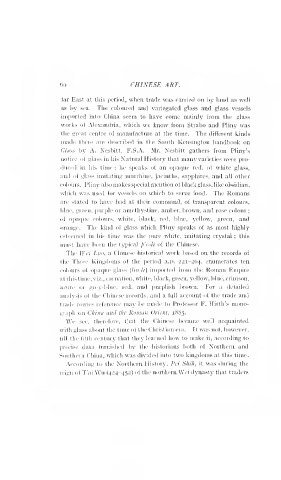Page 220 - Chinese Art, Vol II By Stephen W. Bushell
P. 220
, ;
6o CHINESE ART.
far East at this period, when trade was carried on by land as well
as by sea. The coloured and variegated glass and glass vessels
imported into China seem to have come mainly from the glass
works of Alexandria, which we know from Strabo and Pliny was
the great centre of manufacture at the time. The different kinds
made there are described in the South Kensington handbook on
Glass by A. Nesbitt, F.S.A. Mr. Nesbitt gathers from Pliny's
notice of glass in his Natural History that many varieties were pro-
duced in his time ; he speaks of an opaque red, of white glass,
and of glass imitating murrhine, jacinths, sapphires, and all other
colours. Pliny also makes special mention of black glass, like obsidian
which was used for vessels on which to serve food. The Romans
are stated to have had at their command, of transparent colours,
blue, green, purple or amethystine, amber, brown, and rose colour
of opaque colours, white, black, red, blue, yellow, green, and
orange. The kind of glass which Pliny speaks of as most highly
esteemed in his time was the pure white, imitating crystal ; this
must have been the typical p'o-li of the Chinese.
The Wei Lvo, a Chinese historical work based on the records of
the Three Kingdoms of the period a.d. 221-264, enumerates ten
colours of opaque glass {liii-li) imported from the Roman Empire
at this time, viz., carnation, white, black, green, yellow, blue, crimson,
azure or grey-blue, red, and purplish brown. For a detailed
analysis of the Chinese records, and a full account of the trade and
trade routes reference may be made to Professor F. Hirth's mono-
graph on China and the Roman Orient, 1885.
We see, therefore, that the Chinese became well acquainted
with glass about the time of the Christian era. It was not, however,
till the fifth century that they learned how to make it, according to
precise data furnished by the historians both of Northern and
Southern China, which was divided into two kingdoms at this time.
According to the Northern History, Pei Shih, it was during the
reign of T'ai Wu (424-452) of the northern Wei dynasty that traders

